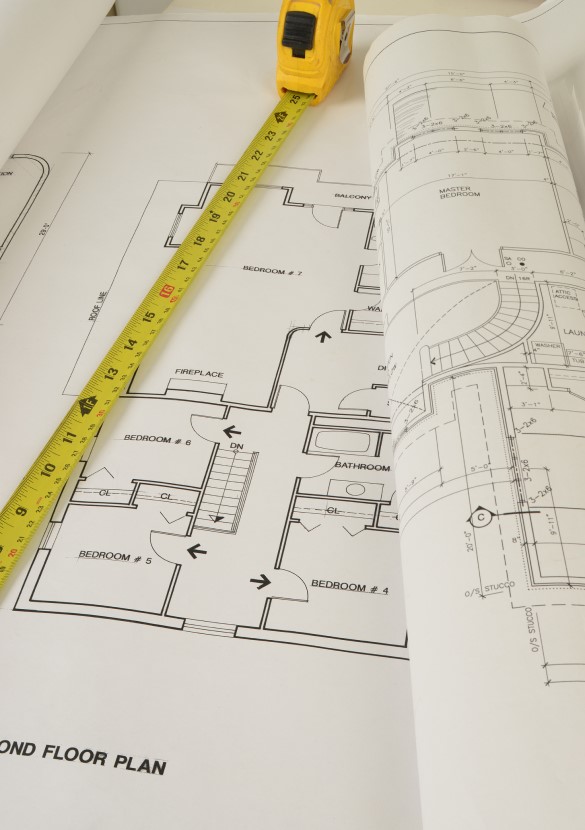A floorplan is often part of the sale or (partial) rental of your home or other property. We can survey and draw up a floor plan for you that meets the NEN 2580 guidelines.
Floorplan (in accordance with NEN 2580)
A floorplan is often part of the sale or (partial) rental of your home or other property. We can survey and draw up a floorplan for real estate agents, lessors, housing associations and private individuals. Naturally all our floorplans completely meet the national NEN 2580 guidelines that offer you and your counterparty certainty about the standards applied and the surface area measurements.
The floorplan also contains measurements in accordance with the desired standard definitions, such as the gross and net floor area (BVO and NVO) and the building’s surface area. If it is a rental property, we can also add the lettable floor area (VVO), dividing up the areas for the tenants of the building in question. We process the data using Floorplanner and generate a 2D or 3D version for each storey, including a FML file that can be imported on Funda.nl.

Talk to our experts
Measurement Certificate (Type A or B)
For our clients, it is important that there is insight in the precise surface area of a building.
As an independent party, we determine the floor area and provide insight in the gross floor area (BVO), net floor area (NVO) and the lettable floor area (VVO).
There are two types of measurement certificate:
- Type A
For a type A measurement, our engineer will go on location to measure the floor area. This is the most accurate and reliable way to draw up a measurement certificate.
- Type B
For a type B measurement, we draw up the measurement certificate on the basis of the construction drawings you provide. Since our engineer does not go on location to survey, it is essential that the drawings are correct. A type B measurement is also the method that we use when construction of the object still has to commence.

NEN2580 and NTA2581
NEN2580 is the standard which stipulates how the surface areas of properties must be determined. NTA 2581 determines how measurement reports, in which the surface areas are determined in accordance with NEN 2580, must be drawn up. Additionally it determines the distinction that must be made between the different measurements. Both the NEN 2580 and NTA 2581 standards were set by the NEN: the Royal Netherlands Standardization Institute.

NEN
Our NEN guidelines

NEN 2580
NEN 2580 is a Dutch standard that contains terms, definitions and methods to determine the floor area and content of buildings or parts of them. The standard also determines surface areas of sites that are destined for buildings.
The purpose of this standard is to make it easier to compare buildings. Use is made of a uniform method to determine basic data that results in comparable information about the ratios between quantities (in m2 and m3) and the costs.
The standard describes various different types of floor area and content of buildings. The following standards are often applied:
- Usable area (GO)
- Lettable floor area (VVO, for non-residential construction)
- Gross floor area (BVO) and net floor area (NVO)
NTA 2581
NTA 2581 “Drawing up measurement reports in accordance with NEN 2580” can be seen as a supplement to NEN 2580. The NTA helps draw up measurement reports in a uniform way that provides clients with clear insight into the results. The NTA amongst other things answers the question of what the difference is between a bill of quantities and a measurement certificate and it stipulates the minimum requirements for drawing up a good and complete quality measurement report.
In this NTA, a distinction is furthermore made between a measurement certificate based on measurements taken from drawings and a measurement certificate based on measurements taken from drawings in combination with verification on location.
In view of the limited demand for measurements of building volumes, the NTA 2581 confines itself to floor surface area measurements.
NEN 2580
NEN 2580 is a Dutch standard that contains terms, definitions and methods to determine the floor area and content of buildings or parts of them. The standard also determines surface areas of sites that are destined for buildings.
The purpose of this standard is to make it easier to compare buildings. Use is made of a uniform method to determine basic data that results in comparable information about the ratios between quantities (in m2 and m3) and the costs.
The standard describes various different types of floor area and content of buildings. The following standards are often applied:
- Usable area (GO)
- Lettable floor area (VVO, for non-residential construction)
- Gross floor area (BVO) and net floor area (NVO)
NTA 2581
NTA 2581 “Drawing up measurement reports in accordance with NEN 2580” can be seen as a supplement to NEN 2580. The NTA helps draw up measurement reports in a uniform way that provides clients with clear insight into the results. The NTA amongst other things answers the question of what the difference is between a bill of quantities and a measurement certificate and it stipulates the minimum requirements for drawing up a good and complete quality measurement report.
In this NTA, a distinction is furthermore made between a measurement certificate based on measurements taken from drawings and a measurement certificate based on measurements taken from drawings in combination with verification on location.
In view of the limited demand for measurements of building volumes, the NTA 2581 confines itself to floor surface area measurements.
Would you like more information about our services?





